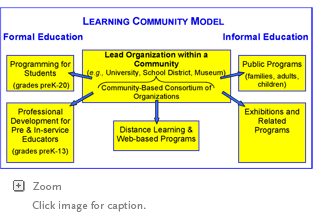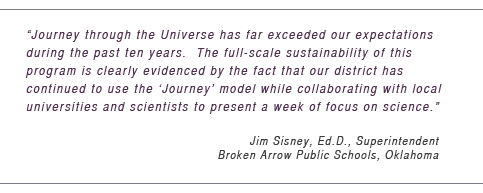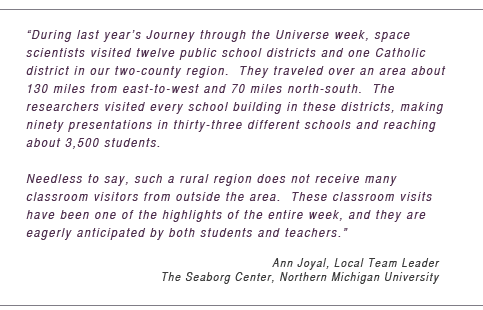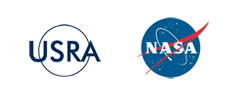|
|
 |
 |
| To understand what the Journey
though the Universe program can offer to your community, it's
appropriate to begin with the program's three core beliefs, defining— |
| |
 |
Our Purpose:
We believe that to continue the legacy of scientific exploration, every
generation must be inspired to learn what we know about our world and
the Universe, and how we have come to know it.
Our Pedagogy:
We believe that learners must see themselves in
the stories we tell, and experience scientific exploration through
their own involvement.
Our Approach to Programs:
We believe that it takes a community to educate a
child...and a network of communities to reach a generation.
|
 |
| |
|
| These beliefs define our
educational purpose, the experience for the learner, and a commitment
to diverse learning experiences across entire communities. |
| |
 |
|
 We believe that stories of
exploration have to be told across an entire community so that students—the next generation—can
be inspired and educated by teachers in the classroom, parents at home,
and educators in informal settings like museums and science
centers. That's why Journey through the Universe offers
a customized suite of programs capable of addressing all
possible audiences and educational venues within a community. We believe that stories of
exploration have to be told across an entire community so that students—the next generation—can
be inspired and educated by teachers in the classroom, parents at home,
and educators in informal settings like museums and science
centers. That's why Journey through the Universe offers
a customized suite of programs capable of addressing all
possible audiences and educational venues within a community.
School programs for students,
professional development for educators, programs for families and the
public, exhibitions, distance learning programs, and experiences
delivered via the web, all provide multiple pathways for
learning. It is a model for the creation of a
'Learning Community'. When these diverse programs
are delivered in concert, allowing leveraging of experiences,
audiences, and resources, the result is truly a community-wide
experience where the whole is far greater than the sum of the
programmatic parts. This is realized at a personal level as
parents and their children take a journey together in subjects relevant
to the curriculum, and parents become engaged in their children's
education.
The Journey through the Universe
Learning Community Model addresses the entire grade prek-20 pipeline,
supporting the continuum of educational experiences that is vital to
ensure both a science and technology literate public and the next
generation of scientists and engineers. Compendia of grade K-12
lessons support the programming. They are developed from national
standards and benchmarks, and most often dovetail so well with the
Earth and space science curriculum at the local level that they can be
adopted as core components of the curriculum.
The Center is therefore uniquely
positioned to take an entire community to the frontiers of exploration
through the Journey through the Universe program. It is
how we've decided to support exploration for generations to come, and
carry on the legacy of those past explorers that dedicated their lives
to revealing the Universe to the human race.
|
| |
 |
| The Learning Community Model
defines the Journey through the Universe program
landscape. Three criteria govern how these programs are
to be delivered— |
| |
 |
The breadth of our
program capabilities allows a community to address their short- and
long-term strategic objectives in STEM
(science, technology, engineering, and mathematics) education by
choosing programming based on their targeted educational
content, educational venues, and audiences. Journey through
the Universe is tailored to the community. It is a
model that deeply embraces the notion that only the community is in a
position to understand their educational needs. The complexion of
programming in each community is therefore unique. |
| |
|
 |
We deliver programs systemically—e.g., providing audiences across entire
school districts with experiences that can be embedded at the
curricular level, and enhanced with programmatic components delivered
through local informal venues such as museums and science centers, and
at home. This approach allows Journey through the Universe
to naturally interface with other systemic educational activities in
the community, e.g., curriculum development, adoption, and
delivery; assessment of student performance; and professional
development for teachers. |
| |
|
 |
We believe that to make a
lasting difference requires a commitment to sustainable
programs providing content and experiences across the community |
 |
| |
on an ongoing basis. The
concept is that the community initially underwrites Journey
through the Universe programming—on a
strictly cost recovery basis—which
transitions by design to sustainable programming that no longer
requires underwriting. First and foremost, such sustainability
requires strategic buy-in from school systems. If that buy-in is
present, then our commitment to sustainability includes: 1) the
training of a team of STEM lead teachers in the community that can
serve as an enduring local content and programming asset; 2) training
on a comprehensive suite of program logistics and scheduling tools; 3)
a programming How-To Manual; 4) a program implementation plan that
includes a transition to full community oversight of program planning
and delivery in the near term; 5) identification of local presenter
talent; 6) an annual conference providing supplemental training, and;
7) extensive content resources that will be provided on a long-term
basis in support of ongoing programming and without charge. |
| |
|
|
 |
| We also believe that a phased
approach to community-wide programming is appropriate. Your
community can define an initial gateway program targeting a
very specific audience. This 'test-bed' approach allows the
community to assess program buy-in and impact, as well as our ability
to deliver national programs at the local level. |
| |
 |
| Community-wide program models
have been developed and assessed over a wide range of environs,
including: under-served rural communities with both large and small
geographic footprints; inner-city urban areas with high minority
populations; a multiple school district model; school district-led,
science center-led, and university-led initiatives; a single grade
level model across a large school system; and a comprehensive grade
preK-20 approach in smaller school districts. |
 |
 |
|
The Learning Community Model
recognizes the diversity of stakeholders in education within a
community, including: school districts, museums/science centers,
universities, civic and business organizations, and the
public. Journey through the Universe therefore
offers you a wonderful framework within which to develop partnerships
with other local stakeholders.
In fact, our ability to deliver
strategic, systemic, and sustainable programming across a community
requires a vibrant partnership between us and a local consortium of
education stakeholders—a Local Team—if we are to deliver effective programming.
We are deeply committed to fostering these long-lasting partnerships,
and we embrace flexible approaches to programming that are capable of
satisfying the strategic goals of all partners.
|
| |
 |
 The Learning Community Model also provides a
framework for national education organizations to pool and deliver
their programming resources. Recognizing this partnership
opportunity, USRA's National Center for Earth and Space Science
Education and NASA's Goddard Space Flight Center signed a NASA Space
Act Agreement. It is a strategic partnership that promotes the
delivery of Goddard education programs and other education assets, by
Goddard's education and research staff, to communities in their
mid-Atlantic service area through the coherent framework of the Journey
through the Universe Learning Community Model. The Learning Community Model also provides a
framework for national education organizations to pool and deliver
their programming resources. Recognizing this partnership
opportunity, USRA's National Center for Earth and Space Science
Education and NASA's Goddard Space Flight Center signed a NASA Space
Act Agreement. It is a strategic partnership that promotes the
delivery of Goddard education programs and other education assets, by
Goddard's education and research staff, to communities in their
mid-Atlantic service area through the coherent framework of the Journey
through the Universe Learning Community Model.
|
|
 |
|
|
